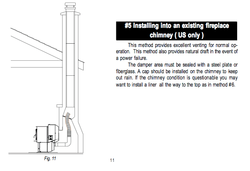Hello, looking for advice RE: converting my old Heatilator zero clearance fireplace into something that can produce real heat. Visited several local stove shops, explained the situation, showed them pictures, and was told that I only have two options: wood pellets or gas. A wood stove or wood insert were not an option because the existing flue is not UL rated to support the heat output of a wood burning stove or insert. Not sure how they could tell that by looking at a picture of the front of the fireplace, but nevertheless - I was fine with it. I really want something that can run continuously, attached to a thermostat, for long periods of time on it's own without care and feeding anyway, so I went the pellet stove route. The Heatilator did not have enough clearance to install an insert and I did not want to rip the entire thing out and destroy the wall and everything around it in the process, so I decided to go with a free standing stove. I plan to install the pellet stove (Harman P68) on the hearth so it will sit immediately in front of the fireplace and use the existing fireplace flue system.
Regarding the installation of the pellet stove, I have been told there are two options:
1. Run the 3 inch pellet stove pipe all the way up inside the full length (+/- 25 feet) of the existing fireplace 8" flue, install all the proper insulation to prevent air leaks, new weather top, etc. OR
2. Run the 3 inch pellet stove pipe into a 3" to 8" adapter and simply attach the adapter to the 8" flue immediately where it enters the top of the heatilator box
I do not have the knowledge to do either of these myself, so I will be hiring a pro to do it. Obviously #1 will cost substantially more than #2 - probably to the tune of at least $1000 more, considering the larger amount of materials and labor involved. I am looking for any advice or compelling reasons, other than price, to choose one option over the other - and would appreciate any words of wisdom on this topic. While price is important, safety and a properly functioning efficient stove are my primary concerns.
Thanks
Regarding the installation of the pellet stove, I have been told there are two options:
1. Run the 3 inch pellet stove pipe all the way up inside the full length (+/- 25 feet) of the existing fireplace 8" flue, install all the proper insulation to prevent air leaks, new weather top, etc. OR
2. Run the 3 inch pellet stove pipe into a 3" to 8" adapter and simply attach the adapter to the 8" flue immediately where it enters the top of the heatilator box
I do not have the knowledge to do either of these myself, so I will be hiring a pro to do it. Obviously #1 will cost substantially more than #2 - probably to the tune of at least $1000 more, considering the larger amount of materials and labor involved. I am looking for any advice or compelling reasons, other than price, to choose one option over the other - and would appreciate any words of wisdom on this topic. While price is important, safety and a properly functioning efficient stove are my primary concerns.
Thanks


